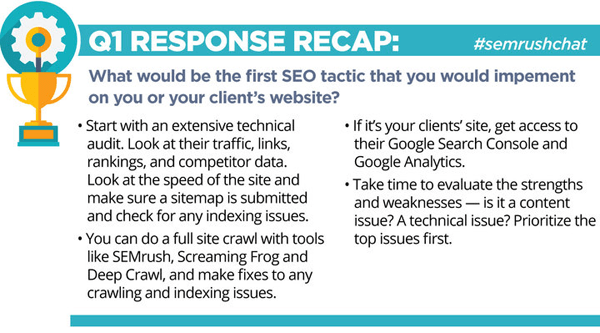6 Ways to Use Old Content

If you can answer "yes" to any of these questions, then repurposing your content indicates you're being strategic, not a slacker.
- Is the content still relevant to the audience?
- Can the content be made relevant again with a refresh?
- Was the content popular before?
- Are there certain audiences who did not see the original content?
- Would the content work in another format?
- Are there pressing updates that need to be made to the content?
For inspiration, let's look at six ways to repurpose content (and be sure to heed our warning at the end).
1. Re-Publish with a New Channel or Format
Marketing software company SEMrush hosts engaging Twitter Chats surrounding the many aspects of SEO. Not only does the company benefit from the real-time interaction on Twitter, but they are also able to compile the insights provided into blogs and graphics. SEMrush chooses responses to include in their blogs and creates recaps for the answers to each of their questions.

Whether it's a Facebook Live video, a company conference or a webinar, if an enterprise has participated on one channel, there is always a smart and strategic way to recap it in another format or for another channel.
2. Create an Editorial Calendar
While not exactly "old content," creating an editorial calendar allows content marketers to recall what they have previously published, analyze how it performed and add material to their new calendar that is more likely to be a success. They do not need to "reinvent the wheel" with new content as many topics require a weekly, monthly or yearly revisit. For example, the products or services offered in a list article with "best" in the title likely change every year. Marketers would be wise to keep track of these pieces to refresh them as needed (again, weekly, monthly or yearly). Access some advice from Google's John Mueller here about how to handle SEO for annual and recurrent events.
Website Magazine wrote, "Content Development Checklist for 2016," which is still very much relevant to 2017. The date in the title, however, would likely turn away readers. By creating a 2017 version (a missed opportunity here), audiences can understand what is important now versus a year ago. Speaking of popular, one way to effortlessly use old content or at least get ideas from it is to know what content has resonated with audiences in the past.
3. Use Your CMS, Analytics Platform or Social Media Tool
As Web professionals, we want to make data-driven decisions, but content is often created in the spur of the moment out of necessity to publish. Inspiration doesn't always strike though, so it is good practice to regularly consult the metrics found within a content management system, analytics platform or social media management tool (or even better, all three).
What are you learning from this information and how can it be shared to empower others?
By reviewing this data often, marketers can take notice of what is being read (and for how long), what is currently being accessed on a site and what is being shared. For instance, on Google Analytics a marketer can see what the most active pages are on their site. It is often surprising to see (in real-time) what articles are being read. An item a marketer didn't plan to update or share on social media, could be very active on their site, demanding a look. By setting up social listening within almost any social media management tool these days, marketers can see what is actively being shared and consider revisiting said content.
4. Say It in a Video
While similar to point number one, videos are a terrific way of repurposing content. If an enterprise has willing participants, almost any content can be discussed in a video.- A whitepaper author discussing his takeaways from the research
- A CEO commenting on her company's recent webinar
- A designer sharing how she created a popular infographic
- A sales manager recapping his favorite blogs of the year
5. Encourage Curation
While not every company will be willing to link to another company's content on their website or share it on their social media channels, many are looking to curate quality content for their audiences. By reaching out to like-minded enterprises, content marketers can get more exposure for their "old" content. What's more, the other company may be interested in collaborating for a new piece with a new angle.
6. Gather Alternative Reviews or Reactions
While content marketers must be aware of an audience's differing opinions on a subject matter, they do not necessarily have to take them into account in their content (as it is their content). One way to repurpose content and still get opposing perspectives is to gather alternative reviews or reactions to a whitepaper, article, webinar, video, presentation or ebook and share it with the same audience. Not only does the content marketer get a fresh piece of content sure to engage those with opposing views, but they also tell a story more fairly and can link back to each of the opposing views. From there, the opposing views can be a whitepaper, article, webinar, video, presentation or ebook (get the picture?).
Be Aware of Self-Plagiarism
To be clear, what we are not saying here is to copy and paste old material into new blog posts. What we are saying is to consider how "old content" can be new again. Content marketing for brand awareness and revenue is not academics or journalism. While content marketing teams holding themselves to a set of editorial standards will likely be better off for it (even when audiences know a company's motive for publishing content, they still don't want to read all-promotional material), this is marketing where resources (like content) should be evaluated and re-evaluated to improve efficiency and results.

Subscribe to Our Newsletter!
Latest in Social Media










